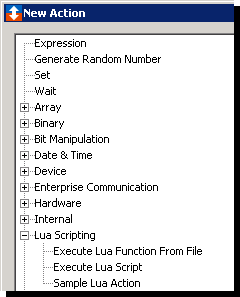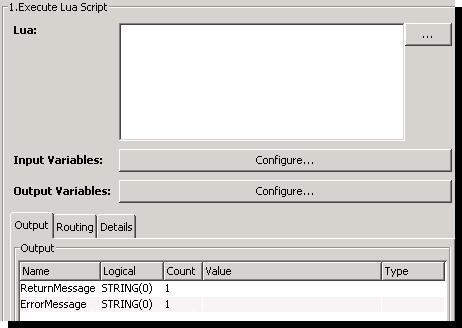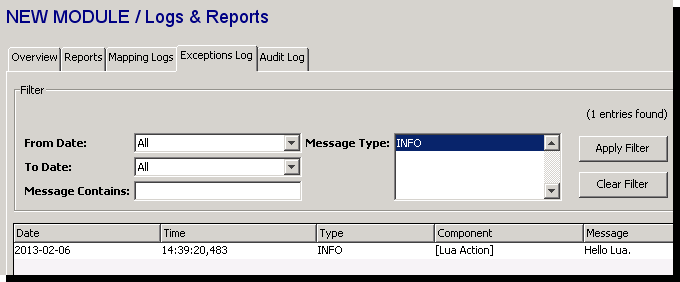Overview
To execute a Lua script directly in a trigger action,
you use the Execute Lua Script
action and embed the Lua script directly in the
action.
Since the Lua script is defined directly in the action it
can be changed by editing the trigger.
The advantage of using this action instead of the Execute Lua Function From File action is that you don't have to upload a separate Lua script file to the Staging Browser.
This section describes how to define a very simple Lua
script, a 1-line script to log an entry into the Exceptions
Log.
The export file for this trigger can be downloaded to your computer and then imported into your node using the Workbench:
Trigger_LUA_SCRIPTS_MyNewTrigger.dwx
The steps described in this example are the same steps that would be used for more complex Lua scripts.
Assumptions
- The Lua extension is installed.
- You know how to define and edit triggers. The trigger List Editor is shown, the Canvas Editor can be used as well. The flow is similar.
On this page
The following will walk you through the steps to define a trigger that will execute a Lua script:
Step 1 - Defining a new trigger
The following describes how to create an
On-Demand trigger event type trigger that
uses the Execute Lua Script action.
- From Workbench left pane, select the
Projects icon.
The Projects tab appears. - Select the project you want to add a trigger
to.
The project tab appears. - Select the New button from the
bottom of the Projects tab.
The New Trigger window appears. - In the Name box, type a name for
the trigger.

- From the Event tab, click the
Trigger Event Type down-arrow, and
then select On-Demand.
You now have a basic On-Demand trigger that can be fired (executed) using the Workbench Fire Trigger option.
You will complete the trigger by adding an action for the trigger to perform.
Step 2 - Adding the Execute Lua Script action
You will add the Execute Lua Script action.
The example shows the use of the Trigger List Editor, the
Trigger Canvas Editor could be used as well.
- From the Actions section at the bottom of the New
Trigger window, select Add.
The New Action window appears.
- Expand the Lua Scripting category,
select Execute Lua Script, and then
select Add.
The right pane is where the specifics of the Execute Lua Script action are defined.
- Fill in the Lua parameter with:
dw.log.exception("INFO","Hello
Lua.")

- Select Validate. If no errors are
reported, select Save.
If there is an error reported, review the information and correct the parameter that has a problem.
Step 3 - Executing the trigger
You will now execute the trigger to cause the Lua script
to execute.
- Find the trigger displayed in its project.

- Select the trigger, then right click the trigger to
display its pop-up menu, and then select
Start.
Or select the trigger and then select the Start button at the bottom of the panel.
The State column for the trigger changes to Started.
- Right click the trigger to display its pop-up menu,
and then select Fire Trigger.
This will cause the trigger to execute, which in turn will execute the actions defined in it. In this example, there is just the one Execute Lua Script action.
Step 4 - Checking the result of the trigger
You will check to see that the Lua script actually
logged a message to the Exceptions Log.
- From Workbench left pane, select the Logs
& Reports icon.
The Logs & Reports tab appears. - Select Exceptions Log tab.

- Check that a new entry has been logged in the
Exceptions Log.
This shows that the simple Lua script executed successfully within the Execute Lua Script action.